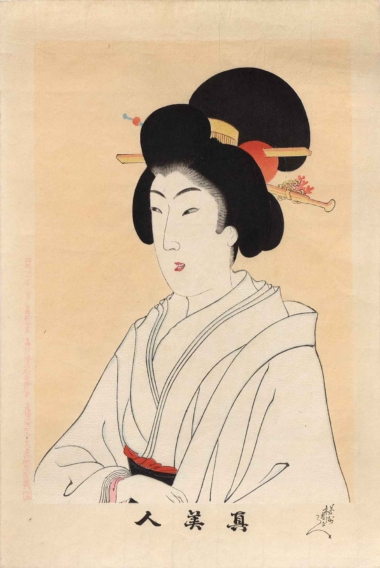
[wpml_linebreak]
New prints
Shin hanga was an art movement to renew Japanese woodblock printing that lasted from about 1915 to about 1960. In addition to beauties (bijin-ga) and landscapes, all the other major subjects of Japanese woodblock prints, famous actors, depictions of birds and flowers, and scenes from modern urban life, are also represented. Along with the ancient values of traditional Japanese woodblock printing, the Shin hanga movement integrated elements from Western painting. Inspired by French Impressionism, the movement picked up effects of light and the expression of individual moods. Woodblock prints of the Shin Hanga movement are characterized by great technical perfection.
The driving force behind the commercial development of the shin hanga movement was the publisher Watanabe Shõzaburõ (1885–1962). He successfully focused on exporting the woodcuts to the European and American markets. Among the most important representatives of the Shin hanga movement are Hiroshi Yoshida (1876–1950), Hashiguchi Goyõ (1880–1921), Hasui Kawase (1883–1957), Natori Shunsen (1886–1960), Shinsui Ito (1898–1972), Kotondo Torii (1900–1976) and Tõshi Yoshida (1911–1995).
After a devastating earthquake in Tokyo on September 1, 1923, firestorms devastated the city, destroying Watanabe’s store and the printing blocks stored there. Particularly sought after are woodblock prints of the Shin hanga movement edited before the great earthquake of 1923.
[wpml_linebreak]
New prints
Shin hanga was an art movement to renew Japanese woodblock printing that lasted from about 1915 to about 1960. In addition to beauties (bijin-ga) and landscapes, all the other major subjects of Japanese woodblock prints, famous actors, depictions of birds and flowers, and scenes from modern urban life, are also represented. Along with the ancient values of traditional Japanese woodblock printing, the Shin hanga movement integrated elements from Western painting. Inspired by French Impressionism, the movement picked up effects of light and the expression of individual moods. Woodblock prints of the Shin Hanga movement are characterized by great technical perfection.
The driving force behind the commercial development of the shin hanga movement was the publisher Watanabe Shõzaburõ (1885–1962). He successfully focused on exporting the woodcuts to the European and American markets. Among the most important representatives of the Shin hanga movement are Hiroshi Yoshida (1876–1950), Hashiguchi Goyõ (1880–1921), Hasui Kawase (1883–1957), Natori Shunsen (1886–1960), Shinsui Ito (1898–1972), Kotondo Torii (1900–1976) and Tõshi Yoshida (1911–1995).
After a devastating earthquake in Tokyo on September 1, 1923, firestorms devastated the city, destroying Watanabe’s store and the printing blocks stored there. Particularly sought after are woodblock prints of the Shin hanga movement edited before the great earthquake of 1923.





Recent Comments